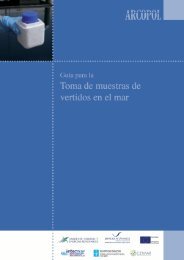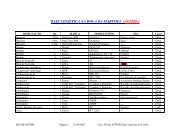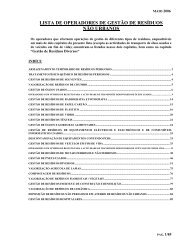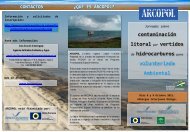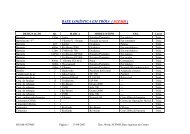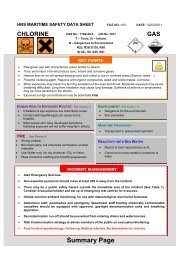methyl amine gas dissolver - Arcopol.eu
methyl amine gas dissolver - Arcopol.eu
methyl amine gas dissolver - Arcopol.eu
You also want an ePaper? Increase the reach of your titles
YUMPU automatically turns print PDFs into web optimized ePapers that Google loves.
HNS MARITIME SAFETY DATA SHEET FILE NO.: 004 DATE: 09/03/2010<br />
METHYL AMINE<br />
GAS DISSOLVER<br />
HUMAN HEALTH CONSIDERATIONS – See Section 3 to 6<br />
ERG 2008 Table 1: Initial isolation and protective action distances<br />
Chemical Name Spill Size Definition<br />
Isolation Zone in DownWind Protection Zone<br />
all directions If Fire No Fire<br />
Methyl<strong>amine</strong><br />
Raw Gas<br />
Flammable Gas. 100 800<br />
1600<br />
All directions<br />
Aqueous<br />
Solution<br />
Flammable Liquid. 50 800<br />
800<br />
All directions<br />
Isolation Distance: All personnel to be directed in a cross wind direction this distance from the spill<br />
Protective Action Zone: A square area down wind of the spill where protective action should be considered, starting with nearest receptors and<br />
working away from spill.<br />
Such estimates should always be regarded with reservations and never be alternatives for monitoring.<br />
Acute Health Hazards<br />
ppm mg m -3 Signs and symptoms<br />
0 - 10 0 – 12.7 No observed effect<br />
5 - 25 6.4 – 32 Slight visual disturbance<br />
10 - 100 12.7 - 127 Transient mucous membrane irritation<br />
100 127 Immediately dangerous to life or health (NIOSH)<br />
Monitoring Strategy (Short & Long Term) & Equipment – See Section 6<br />
Health and Safety<br />
Environmental<br />
Public Health<br />
Air - Real-time photionisation detection or quantitative colour change tubes (Draeger or similar).<br />
Monitors MUST be intrinsically safe / ATEX compliant. Monitor Oxygen in confined spaces<br />
Atmospheric fate and transport e.g. Aloha (immediate risk / first response), Calpuff (longer term)<br />
GP referrals, hospital admissions – numbers, symptomology, follow-up studies. (See Biomarkers)<br />
OPERATIONAL EMERGENCY RESPONSE – See Section 8 & 9<br />
Fire fighting<br />
measures:<br />
Decontamination of<br />
responders<br />
Response &<br />
Clean up:<br />
Waste Management<br />
Use fine water spray for <strong>gas</strong> clouds. Use water to cool tanks, cylinders etc. Use CO 2 or foam<br />
against small fires. May form toxic <strong>gas</strong>es during combustion - Nitrogen Oxides<br />
Decontamination should be performed using local protocols in designated areas with adequate<br />
ventilation. Water should be contained and disposed of at an appropriate waste facility.<br />
Decontamination run-off should be prevented from entering drains and watercourses.Ventilate<br />
confined spaces. Absorb liquids and dispose accordingly.<br />
Dispose as hazardous waste. Methyl<strong>amine</strong> <strong>gas</strong> is volatile and non persistent. Solutions will be<br />
biodegraded in the environment. Controlled incineration is suitable for contaminated materials..<br />
EMERGENCY CONTACTS<br />
ORGANISATION<br />
TELEPHONE<br />
FIRE, AMBULANCE, POLICE 999<br />
HEALTH PROTECTION AGENCY: Chemical Hazards Unit 08448 920555<br />
ENVIRONMENT AGENCY: 24/7 Pollution 0800 807060<br />
PAGE 2 OF 11<br />
Summary Page




